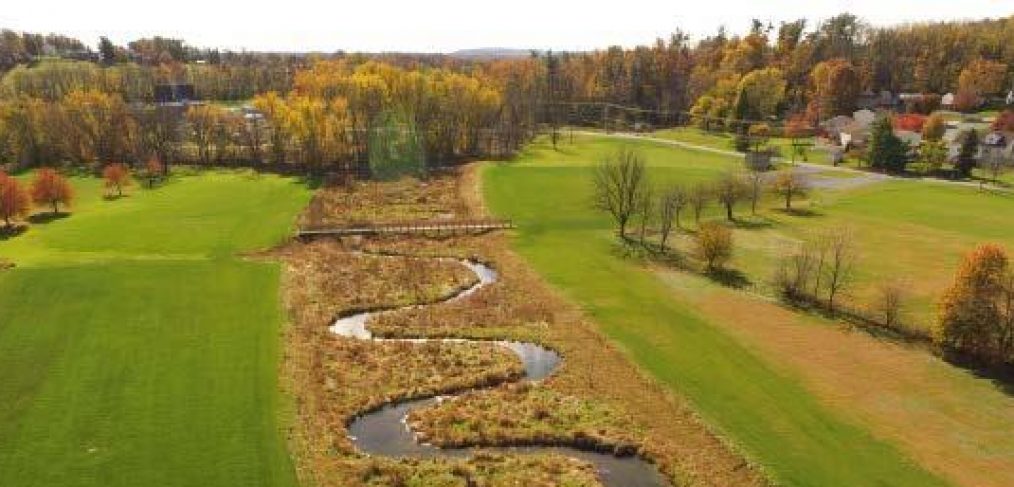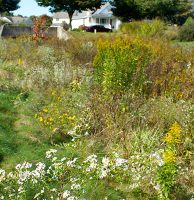
Parks can Play a Major Role in Managing Stormwater
As stated in LandStudies’ white paper, Municipal Separate Storm Sewer Systems (MS4s), Municipalities, and Parks, “Park professionals see firsthand the impacts flooding can have on parks and surrounding areas. They may have to move park structures to higher ground before a severe storm or replace water damaged infrastructure after a flood. Yet parks and other open spaces (rights-of-way, along streets, parking lot medians, etc.) are the most ideal places in a municipality to generate a variety of long-term economic, ecological, and community benefits,” such as water quality and quantity improvement and infrastructure protection.
Incorporating green infrastructure for stormwater management into parks provides a community with two major benefits: meeting regulatory requirements, such as those related to MS4 permits, and enhancing a public asset for the betterment of the entire community. Any well-established park will have facilities in need of renovation or retrofit over the years, offering opportunities to manage stormwater “naturally” on-site. Parks yet to be built can have green infrastructure designed and installed from the beginning, reducing costs.
Green infrastructure for stormwater management may include:
- Rain gardens: these shallow depressions in the ground are planted with various native plants to treat and capture stormwater runoff. They can be placed in areas visible to park visitors and would be enhanced with educational signage.
- Porous pavement (also known as pervious or permeable): unlike regular paving that allows water to quickly run off, porous pavement allows precipitation to soak into the ground. Storage cells or other structures may be placed under the pavement to add additional filtration benefits.
- Vegetated swales: these shallow channels are planted with various native plants and used instead of underground pipes and concrete channels to move stormwater from one location to another. They have the bonus of allowing for infiltration and cleaning of the runoff.
- Naturalized infiltration basins: these are depressions in the ground that provide temporary storage and infiltration of runoff. They are planted with myriad natives to provide wildlife habitat and to look aesthetically pleasing.
- Streambank and/or floodplain restoration: this best mimics the interaction of groundwater, stream flow, and plant roots to reduce flooding, filter out pollution, recharge groundwater, prevent erosion, and lessen stream flows. The restoration may include grading streambanks to make them less steep, planting trees and other native vegetation, creating pools and meandering channels in the stream, and restoring wetlands. Any park with a stream, river, pond, or lake may benefit from these restoration practices. Incorporating stream access for fishing and wildlife viewing will enhance the visitor experience.
- Stormwater runoff capture and/or reuse: this may consist of a simple rain barrel attached to the gutter downspout on a visitor center building to more complex underground storage tanks or cisterns. The water collected in these devices can be used to irrigate gardens, wash vehicles, etc.
Additional information can be found through the PA Department of Conservation and Natural Resources (DCNR) here.
A Successful Park Example
The National Recreation and Parks Association (NRPA) recognizes the importance of green infrastructure in parks for stormwater management. In April 2017, they discussed the topic on their website. The article featured the 5-acre Evans Parkway Neighborhood Park in Montgomery County, Maryland, which after 50 years of use was in major need of infrastructure upgrades and repairs.
The Maryland-National Capital Park and Planning Commission decided to replace the many concrete channels and underground pipes with green infrastructure stormwater management techniques to serve as a demonstration site for future park projects and to engage the local communities in protecting the health of their local watersheds. The commission also submitted the site for the Sustainable Sites program (also referred to as LEED for Landscapes), for which it received a 3-star rating. The total cost of the project was $3.65 million, with more than half the funds coming from Maryland’s innovative Program Open Space. Because of its success, more Maryland parks are following suit.
Andy Frank, a civil engineer and supervisor of the park development division said of the project, “We have found that by treating parts of a watershed as distinct elements of original natural systems, rather than piping stormwater to one central pipe or holding facility, it has allowed for many improvements in treating stormwater on-site, especially using groundwater recharge as a means of allowing soils and wetlands to soak up stormwater and to extend the base flows of streams.”
To learn more about how LandStudies is incorporating stormwater management and green infrastructure into park projects, go to www.landstudies.com and search for “park”.


